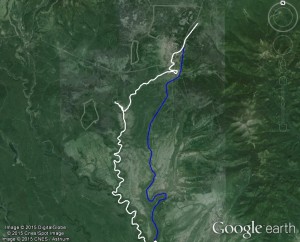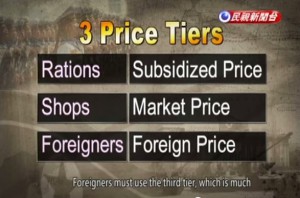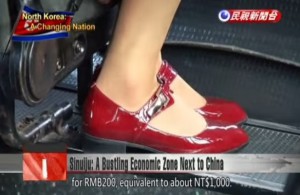Pictured Above (Google Earth): The new Samjiyon railway line route (in blue) and the original narrow gauge line (in white)
UPDATE (2015-11-18): According to the Pyongyang Times:
Broad-gauge railroad construction makes good headway
The project for building a broad-gauge railway between Hyesan and Samjiyon is being pushed briskly.
According to information available, the work for roadbed has been carried out by 80 per cent and that for small structures by over 70 per cent as of mid-November.
The field construction headquarters set a goal to speed up the construction of roadbed, railway bridge, tunnel and retaining wall for the first-stage assignment and complete the building of small structures by the end of this year, and is concentrating all efforts and means on its implementation.
To wind up wet project before the soil is frozen it is organizing the guidance over the execution of construction scrupulously while seeking the ways to carry on construction uninterruptedly even in winter.
Every construction group ensures that the flames of creating a new Korean speed flare up in all construction sites by arousing the enthusiasm of members of the shock brigade.
In the wake of having cut two tunnels through, the members of the South Hwanghae provincial construction group are pushing the projects for roadbed, retaining walls and small structures in a three-dimensional way.
Ministries and national agencies, the Pyongyang municipal construction group and the northern railway construction youth shock brigade have completed the construction of three railway bridges.
The flames of innovation for rounding off the projects as soon as possible are also blazing up at the workplaces of the North and South Hamgyong provincial construction groups.
Though working at the section with the most unfavourable working conditions, the members of the Jagang provincial construction group overfulfil their assignments two or three times every day.
Builders are making collective innovations in every workplace while putting the main stress on ensuring the speed and quality of construction.
UPDATE 3 (2015-10-7): Naenara announces that work has begun on the new line. You can read the PDF here.
UPDATE 2 (2015-6-17): I discuss this new railway project on Radio Free Asia.
UPDATE 1 (2015-6-4): KCNA announces work on Samjiyon railway line. According to the article:
A broad-gauge railroad from Hyesan to Samjiyon will be constructed.
A ground-breaking ceremony took place before the Samjiyon Grand Monument on Thursday.
Present there were O Su Yong, secretary of the C.C., the Workers’ Party of Korea, officials concerned, builders and working people in Samjiyon County.
The participants laid bunches of flowers before the statue of President Kim Il Sung at the Samjiyon Grand Monument and paid tribute to him.
O Su Yong made a report to be followed by speeches.
The reporter and speakers said the construction of the new railroad is a sacred work for glorifying forever the immortal exploits performed by Kim Il Sung and leader Kim Jong Il in the area of Paektu and their revolutionary careers.
They called on all builders to wind up the project as scheduled by overcoming hardships and difficulties.
ORIGINAL POST (2008-10-19): According to the Daily NK:
North Korean authorities have started construction for expanding the railway connecting Hyesan, Yangkang Province and Samjiyeon from a narrow to a broad railroad.
An inside source from Yangkang Province relayed in a phone conversation with the Daily NK on October 16th, that “Since the 1st of this month, the ‘Shock Brigade for the Propagation of Party Ideology (the June 18th Shock Brigade)’ came and started preparing for expanding the railway between Hyesan and Samjiyeon. Now, they are building housing for brigade members who will begin construction in early November.”
According to the source, the Hyesan-Samjiyeon railway was a “narrow gauge (railroad)” which connected the rail between Hyesan and Bocheonbo to Samjiyeon Lake in the mid-1980s and only small cars which fit 38 people could travel on it. Not only was it a railroad on which small trains could travel, it suffered significant damage in the 1994 mass flood and ceased operations until recently.
The North Korean authorities believed that Samjiyeon played an important role to propagandize Kim Il Sung and Kim Jong Il’s revolutionary ideology, so they attempted to build a “broad gauge” between Hyesan and Samjiyeon when Kim Il Sung was alive. However, the project is still under construction due to the nation’s weak financial predicament and rough construction environment.
The source relayed, “The number of construction workers totals approximately 50,000 people, including 30,000 ‘June 18 Shock Brigade members and 20,000 others mobilized from rural areas, enterprise officials, and farms. The area of construction is approximately 70km, but it is a rough, mountainous terrain, so the construction will not be easy.”
He also stated, “Currently, a part of the Shock Brigade have come in to build housing, but at the end of October, all members will come. The Shock Brigade is in charge of doing construction far from the city and in some places near the city, and the enterprise officials or farmers will take charge and lead the construction.”
At the news of the beginning of the railroad construction, citizens showed a welcoming and a concerned response.
The source said, “The merchants are glad at the opportunity to make money, but the farmers are all concerned that the number of thieves will increase on the farms. The place where construction will take place is near the border region, so smugglers are concerned that the border patrol will become toughened.”
The source added that, “The Shock Brigade mobilized for the construction has said that the construction has to be completed before the 100th anniversary of the Supreme Leader’s (Kim Il Sung) birthday in 2012. That is why people have been rushing to begin construction despite the coming of winter.”
The Los Angeles Times reported on the 27th of last month that the construction of high buildings has been rapidly taking place in Pyongyang and hotels and theaters have also been refurbished. The construction of the 107-story Ryukyung Hotel, which has been left under construction for a long time, also has resumed.
The LA Times pointed out the fact that such construction is taking place when the World Food Programme (WFP) has warned of an economic crisis as serious as in the mid-1990s, during which 2,000,000 starvation deaths resulted in North Korea, is simply miraculous and outrageous.
Read the full story here:
Railway Construction by Kim Il Sung’s 100th Birthday Takes Precedence
Daily NK
Lee Sung Jin
2008-10-19



